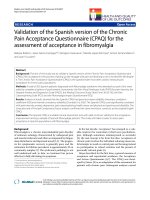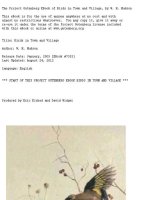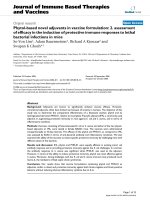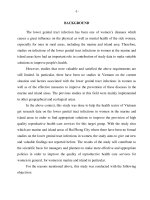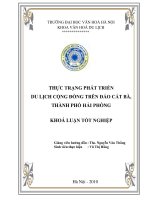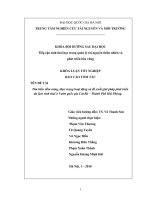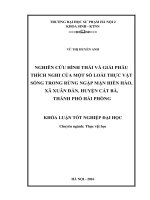Assessment of the diversity of birds in cat ba national park hai phong city
Bạn đang xem bản rút gọn của tài liệu. Xem và tải ngay bản đầy đủ của tài liệu tại đây (1.09 MB, 66 trang )
MINISTRY OF AGRICULTURE AND RURAL DEVELOPMENT
VIETNAM NATIONAL UNIVERSITY OF FORESTRY
STUDENT THESIS
Title
ASSESSMENT OF THE DIVERSITY OF BIRDS
IN CAT BA NATIONAL PARK, HAI PHONG CITY
Major: Natural Resources Management (Advanced Curriculum)
Code:
D850101
Faculty: Forest Resources and Environmental Management
Student: Nguyen Minh Quang
Student ID: 1253091561
Class: K57 Natural Resources Management Course: 2012 – 2016
Advanced Education Program
Developed in Collaboration with Colorado State University, USA
Supervisor: Dr. Dong Thanh Hai
Hanoi, October 2016
ACKNOWLEDGEMENTS
This thesis cannot become a reality without kind support and helps of many
individuals, I would like to extend my sincere thanks to:
The heads of Vietnam National University of Forestry, Faculty of Forest Resources and
Environmental Management provided opportunity, essential conditions for me to finish
this research.
I am grateful to my supervisor, Dr. Dong Thanh Hai, whose expertise,
understanding, generous guidance and continuous support made it possible for me to work
on a topic that I chose. It was my pleasure being his student.
I would like to express my gratitude to Prof. Lee MacDonald for finding out the time to
check and give advises to my proposal.
I am hugely indebted to Mr. Thao A Tung for spending time and consideration to
guide and provide useful information related to my topic.
I would like to express the deepest appreciation to the heads, officers of Cat Ba NP, local
people there for providing me useful information and kind consideration and help.
Besides, I would like to thank my family, acquaintances for their encouragement,
support during the period of conducting this study. Without their support, I would not have
been able to complete this thesis.
Despite spending the best efforts in the thesis conducting process, this research still
has many shortcomings due to the limitations of time, finance and my ability. I am looking
forward to receiving comments from teachers, friends to a better thesis completion.
Thank you!
Hanoi, October 2016
Author: Nguyen Minh Quang
TABLE OF CONTENTS
ACKNOWLEDGEMENT
TABLE OF CONTENTS
ABBREVIATIONS
LIST OF TABLES
LIST OF FIGURES
ABSTRACT ......................................................................................................................... 1
PART I. INTRODUCTION .............................................................................................. 2
PART II. GOALS AND OBJECTIVES, METHODOLOGY ........................................ 6
2.1. OBJECTIVES ........................................................................................................................................... 6
2.1.1. Goals .................................................................................................................... 6
2.1.2. Specific objectives ............................................................................................... 6
2.2. METHODOLOGY .................................................................................................................................. 6
2.2.1. Prefield study preparaion ..................................................................................... 6
2.2.2. Field surveys ........................................................................................................ 7
2.2.2.1. Interviewing .................................................................................................. 7
2.2.2.2. Line transect survey ...................................................................................... 8
2.2.2.3. Mist net ......................................................................................................... 9
2.2.2.4. Threat assessment to birds and their habiats ............................................. 10
2.2.2.5. Data analysis .............................................................................................. 11
PART III. STUDY SITE .................................................................................................. 13
3.1. NATURAL CONDITIONS ................................................................................................................. 13
3.1.1. Geographic location ........................................................................................... 13
3.1.2. Climate and hydrology ...................................................................................... 13
3.1.3. Vegetation .......................................................................................................... 14
3.1.4. Fauna ................................................................................................................. 15
3.2. ECONOMY – SOCIETY ..................................................................................................................... 16
3.2.1. Population and employ ...................................................................................... 16
3.2.2. Livelihood .......................................................................................................... 17
3.2.2.1. Production of industrial and handicraft ..................................................... 17
3.2.2.2. Agricultural production .............................................................................. 18
3.2.2.3. Economic forests ......................................................................................... 19
PART IV. RESULTS AND DISCUSSION ..................................................................... 20
4.1. BIRD SPECIES COMPOSITION IN CAT BA NP ........................................................................ 20
4.1.1. Species composition .......................................................................................... 20
4.1.2. Species composition structure ........................................................................... 22
4.2. DISTRIBUTION OF BIRDS OBSERVED IN CAT BA NP ....................................................... 24
4.3. BIRD CONSERVATION VALUE IN CAT BA NP ..................................................................... 27
4.4. THREATS TO BIRDS IN CAT BA NP ........................................................................................... 30
4.4.1. Hunting, trapping ............................................................................................... 31
4.4.2. Wood and non-timber forest product exploitation ............................................ 33
4.4.3. Forest fire ........................................................................................................... 34
4.4.4. Grazing cattle. .................................................................................................... 35
4.4.5. Tourism.............................................................................................................. 37
4.4.6. Threats ranking .................................................................................................. 37
4.5. PROPOSING SOLUTIONS FOR BIRDS CONSERVATION IN CAT BA ........................... 38
4.5.1. Solutions to minimize the threats to birds and their habitats ............................. 38
4.5.1.1. Hunting and trapping .................................................................................. 38
4.5.1.2. Wood and NTFP exploitation ..................................................................... 39
4.5.2.3. Forest fire ................................................................................................... 39
4.5.2.5. Tourism ....................................................................................................... 40
4.5.3. Strengthening law, policy imforcement ............................................................ 40
4.5.4. Raising awareness of people and livelihood improvement ............................... 40
4.5.5. Strengthen scientific research ............................................................................ 41
4.5.6. Strengthen international cooperation ................................................................. 41
4.5.7. Ecotourism development ................................................................................... 41
PART V. CONCLUSIONS .............................................................................................. 42
REFERENCES
APPENDIX
ABBREVIATIONS
NP:
National Park.
CITES: the Convention on International Trade in Endangered Species of Wild Fauna and
Flora.
IUCN: International Union for the Conservation of Nature.
NTFP: Non-timber forest product.
LIST OF TABLES
Table 2.1. Information of transects set in the study site ....................................................... 8
Table 2.2. Checklist of bird species inCat Ba NP ............................................................... 11
Table 2.3. List of rare bird species in Cat Ba NP ............................................................... 11
Table 2.4. Ranking of threats to Bird resource in Cat Ba NP ............................................. 12
Table 3.1. The population situation of the commune, town in Cat Ba island ..................... 17
Table 4.1. Species diversity in Cat Ba NP .......................................................................... 20
Table 4.2. Bird resource of Vietnam and Cat Ba National Park ......................................... 24
Table 4.3. Bird species detected in habitats ........................................................................ 24
Table 4.4. List of rare bird species in Cat Ba NP ............................................................... 28
Table 4.5. Ranking of threats to Bird resource in Cat Ba NP ............................................. 38
LIST OF FIGURES
Figure 2.1. Map of Cat Ba National Park .............................................................................. 8
Figure 4.1. Bird species recorded from sources of information in Cat Ba NP .................... 21
Figure 4.2. The diversity of families of birds in the park .................................................... 22
Figure 4.3. The diversity of bird species in the park ........................................................... 23
Figure 4.4. Bird species distribution according to habitats.................................................. 27
Figure 4.5. Common hill myna kept in a local family ......................................................... 32
Figure 4.6. Bird trap using Eurasian tree sparrow's roundelay ............................................ 33
Figure 4.7. Rangers seized illegal timber in Cat Ba National Park. .................................... 34
Figure 4.8. Historical forest fires in Cat Ba (2009-2013) .................................................... 35
Figure 4.9. Goats go foraging on rocky mountain ............................................................... 36
Figure 4.10. A woman prepares looks after her cattle in Cat Ba ......................................... 36
Figure 4.11. Trash from tourism activities near Frog Pond ................................................. 37
ABSTRACT
Bird is the most diverse vertebrate animal group in Vietnam, hence, it is necessary
to have as many assessments, researches as posible to propose the most accurate
information about the topic. Cat Ba NP is considered as a potential area in terms of
biodiversity conservation due to its diversified species and habitat. Due to various causes
such as: hunting, trapping, wood and NTFPs exploiting, forestfire, grazing catlle, tourism...
birds and thier habitat are being influenced. This assessment was conducted from July to
October of 2016 in Cat Ba NP in order to provided a checklist of birds in the study area, as
well as the distribution of birds in 4 main habitats and also the conservation value of some
species. The threats to birds and thier habitats were assessed to propose the solutions for
birds conservation and management in Cat Ba NP. Interviewing, line transect survey, mist
net and data analysis methods were used to collect the information, data about birds in the
study site. The results of the study reveal that there are 209 bird species belonging to 51
families, 17 orders. The observed species distributed mostly in natural forests, followed by
artificial forests and mixed of natural and artificial forests; in the shrub and grassland was
the habitat with least species observed compared to the 3 mentioned habitats. There are 17
bird species were listed in Vietnam redbook, IUCN (2016-2), CITES (2014) and Decree
32/2006/ND-CP with the high value of conservation. The study has recommended
solutions for effective, sustainable birds conservation and management in Cat Ba NP.
1
PART I. INTRODUCTION
The avifauna of Vietnam is diverse and abundant with 887 species belonging to 88
families and 20 orders (Nguyen Lan Hung Son and Nguyen Thanh Van, 2011). The
number of known bird species in Vietnam makes up over 9% of the total known birds on
Earth with 9800 species (James, Clements F. 2007). There are 13 endemic species, 40 rare
birds are threatened on the global scale and 75 species are suffering the risk of extinction at
the national level.
Bird belongs to the widely distributed groups. This extent of distribution depending
on biological, ecological characteristics of each species creates the richness and diverse for
the community. Birds play an important role in forest ecosystem. Birds play an important
role in forest ecosystems, are one key step in the process of transforming energy and
material, are a vital link in the food web which keeps the forest ecological balance. Many
high-value species used as food, medicinal, ornamental, cultural, ethnographic, scientific
research....
In the recent decades, due to the irrational exploiting and using process, the
pressure of population growth, the weak, loose in management and other reasons so forest
resources have declined in quantity and quality. The decrease in natural forest cover area
along with excessive hunting have threatened the existence of many species. Wild animals
have been herded into misery for foods and places to live. Many wild species became
extinct in the nature and numerous species are now at risk of being threatened. Thence, the
issues for the authorities are quickly finding out the solutions for effective resources
management. To have the reasonable, practical and effective solutions, it is priority to have
the processes of investigation, study and master the ecological characteristics, status and
threats of each species.
2
Bird is the most diverse vertebrate animal group in Vietnam. Because of its
importance and high values, bird has been serious threatened in recent decades. The
population of birds has decreased significantly. Hence, the Vietnamese government and
also the international organizations have proposed solutions to improve this situation by
proposing decrees, conventions such as:
- Vietnam red data book: Vietnam red data book is the list of animals and plants in
Vietnam that are rare species, species that declined in number and may come to extinction.
The levels of risk access in the book are: CR- Critically endangered; EN- Endangered; VUVulnerable; NT- Near threatened; LR- least concerned.
The latest released list in 2007 shows that there are 418 endangered species of
animals according to risks of extinction. The number consists of 75 of birds, specially 11
ranked CR, featuring white-winged wood duck (Carina scutulata), The imperial pheasant
(Lophura imperialis), Eastern imperial eagle (Aquila heliacal), 16 ranked EN such as
Black-faced spoolbill (platalea minor), Spot-billed pelican (plecanus philippensis), 27
ranked VU such as Siamese fireback (Lophura diardi), Ring-necked pheasant, 11 ranked
LR and 10 uncategorized, ranked DD- Data deficient.
- IUCN Red data list: is the inventory of the global conservation status of all
biological species, which is abbreviated to IUCN (International Union for Conservation of
Nature and Natural Resources). The levels of extinction risk in Vietnam red data book are
similar to those in IUCN Red list. Up to now, the list has evaluated over 79,800 species
that may come to extinction according to categories.
- CITES: The Convention on International Trade in endangered species of wild
fauna and flora is a multilateral treaty to ensure that international trade in specimens of
wild animals and plants does not threaten the survival of the species in the wild. CITES
3
contains 5,000 animal species and 25,000 plant species, and is divided into 3 appendices I,
II, III with different levels of being threatened to existence species.
- The decree No. 32/2006/ND-CP dated 30/03/2006 is a government decree on
Management of Endangered, Precious, and rare Species of Wild Plants and Animals. It has
classified wild, precious and rare animals into 2 groups according to the risk of extinction
and the protection of law towards these species. These two are: Group IB (Prohibiting
exploitation and use for commercial purposes, including wild plants, animals, for which
populations are very small in the wild or are in high risk of extinction) and Group IIB
(Restricting exploitation and use for commercial purposes, including wild plants and
animals, for which populations are small in the wild or are in risk of extinction).
Cat Ba National Park is a national park in Northern Vietnam, situated on Cat Ba
Island, Ha Long Bay and is administered by Cat Hai District, Hai Phong City. It was
established on 31 March 1986 includes marine ecosystems, terrestrial forest ecosystem,
mangrove ecosystem.The park is located approximately 55 kilometers East of Haiphong,
covering a total natural area of 16,196.8 ha, in which 10,931.7 ha is forest and mountain
and 5,265.1 ha is the sea, covering most of Cat Ba Island. The main forest type is
evergreen tropical rain forest, but due to the terrain, soil and water regimes there are also
some types of secondary forest: limestone forest, mangroves, freshwater wetland forests in
the mountains. Inside the park, there are 343 species of fauna including 53 mammals, 205
birds, 53 reptiles and 25 amphibians.Cat Ba NP is the habitat of many rare bird species
such as: However, due to the impact of human and other causes, wildlife resources in
general and bird in particular have declined.There are still many mysteries in the nature of
Vietnam and especially the bird resource in Cat Ba NP so it is necessary to have more
research on species composition and other values of bird in the study site.
4
A checklist (Vo Quy and Nguyen Cu, 1999) gives a total number of 828 species,
however, this ignored some species found within the country. More recent evaluation, in
which numerous species were mentioned (Eames et al. 1999a;1999b), the national total
number of bird species has reached 850 (making upabout 9% of the total number in the
world). Approximately 200 species of migratory species recorded as non-resident (Gov. of
SRV, 1994). Within Vietnam, 4 endemic bird species areas have been identified by
Birdlife International: the Annamese lowlands, the Kon Tum Plateau, the Da Lat Plateau
and the southern Vietnamese Lowlands. These host 22 restricted range species, 10 of
which are believed to be endemic to Vietnam (Birdlife International, 2002).
A short review of bird surveys at Cat Ba National Park, places the number of extant
species at 124 (Nadler and Ha Thang Long, 2000). The aim of the bird survey conducted
by Frontier-Vietnam was to compile a species list for the area and collect information
regarding ecological distributions (Furey, N., Le Xuan Canh & Fanning, E., 1999)
An evaluation of fauna at Cat Ba NP (Do Tuoc, 2013) was conducted and it gives
the information of bird species which its total number of species has reached 205. This is
the most complete and recent study of birds in the study site.
The documents about Birds in Cat Ba NP are very few, the data change over year.
Deriving from this practice, I have chosen the topic: "Assessment of the diversity of Birds
in Cat Ba National Park, Hai Phong city". This study was conducted to contribute useful
information for protection and management of bird in particular and forest resources in
general in Cat Ba NP.
The results collected from the study will be used for planning and also preparing
technical measures to manage, protect and develop effective biodiversity.
5
PART II. GOALS AND OBJECTIVES, METHODOLOGY
2.1. OBJECTIVES
2.1.1. Goals
Investigating the characteristics of Birds and assessing the threats in order to
contribute in building a scientific basis for Birds conservation in Cat Ba National Park.
2.1.2. Specific objectives
- To study species composition diversity of Birds in Cat Ba National Park.
- To study the distribution of Birds by habitat in Cat Ba National Park.
- To assess threats to Birds and their habitats in Cat Ba National Park.
- To give solutions for management, conservations and sustainable development of Birds
in Cat Ba National Park.
2.2. METHODOLOGY
This research was conducted from 01/07/2016 to 25/09/2016 and the field
investigation was from 08/08/2016 to 25/08/2016.
2.2.1. Prefield study preparaion
The following documents werecollected before the field data collection:
- Topographic maps, status map the study area;
- Birds identification document;
- Data sheet;
- Field equipment: binoculars, camera, GPS, bird mist nets, tape...
- Identifying preliminary survey transects.
6
2.2.2. Field surveys
2.2.2.1. Interviewing
This method was used to collect the information about species composition, status,
distribution and the bird exploitation status in the study site.
Furthermore, interviewing contributes to collect the information about birds or
specimens from bird which were being kept in some local families. Those are the
evidences to determine the species composition in the study site.
The total 50 interviewees are national park officials and local people. In which, for
the officials, I interviewed 5rangers and 5 officials of Cat Ba NP. For the local people, 40
people who were interviewed are tourists, hunters, people living around the buffer zone
usually go into the forest to collect, exploit wood, firewood, non-timber forest products,
graze cattle.
Questionnaire 2.1
Interview local people and hunters
Name:…………………….….................; Age:……………………………..
Ethnic:…………………………….…….; Date:…………………….............
Number of questionnaire:.................; Address:…...........................................
Occupation:.......................................................................................................
Interviewer:.......................................................................................................
No.
Common
name
Local
name
Amount
Habitat
1
2
…
7
Location
Using
value
Note
2.2.2.2. Line transect survey
Transect survey was conducted in order to identify the species composition, main
habitats and threats to birds in the study site.
The line transects were established based on forest status, topographic maps and
also the information which was preliminary interviewed about bird distribution. The
transects were across some types of habitat, each transect length, depending on terrain, was
from 2-5km. The survey time was in the early morning (after finishing setting up mist nets)
and late afternoon (before setting up mist nets). The chosen transects represented each
habitat of the study site. The detail of the transects was shown in table 2.1 and figure 2.1.
Table 2.1. Information of transects set in the study site
Tran
sect
no.
Begging point's
coordinates
Ending point's
coordinates
1
20°47'38N
106°59'21E
20°48'52N
107° 0'22E
3.5 km
2
20°47'36N
106°59'24E
20°47'54N
107° 0'11E
2.5 km
20°47'23N
106°59'43E
20°47'10N
107° 0'9E
20°47'26N
106°59'40E
20°47'33N
107° 0'49E
20°46'10N
107° 1'13E
20°46'16N
107° 1'32E
3
4
5
Transect
length
2.21 km
Habitats
Grass and shrub, stream and
river, artificial forest, natural
forest, rocky mountain
stream and river, artificial
forest, natural forest, rocky
mountain
artificial forest, natural forest,
rocky mountain
2.5 km
Artificial forest, natural forest
2.13 km
Residential, artificial forest,
natural forest, rocky
mountain, grass and shrub
Figure 2.1. Map of Cat Ba National Park
8
2.2.2.3. Mist net
Bird trapping by mist net was conducted in order to identify the species
composition and study the biological, ecological characteristics of the birds which find
food or shirk under the forest canopy.
The mist nets were set in the early morning or late afternoon which are 2 periods
when birds are most active. Mist nest was specifically designed, less reflective therefore, it
is hard for birds to recognize. Mist nets were set in the flat area with less sunlight to avoid
the detection of birds, in 4 types of habitats: natural forest, artificial forest, mixture of
natural and artificial forest, shrub grassland. There were 7 mist nets was set in each habitat
in 4 days. However, 3 nets set in the artificial forest were stolen by the local people. The
net checking was conducted every 2-3 hours. The individual stuck in the net was carefully
remove out to avoid hurting and killing the species. The result would be noted in the table:
Questionnaire 2.2
Investigate birds by mist net
Investigator: ………………….….…………………..........................................
Date:.....................................................................................................................
Habitat:.................................................................................................................
Mist net number:……………………..................................................................
Coordinate:...........................................................................................................
Weather:………………………...........................................................................
No.
Local name
Scientific
Amount
name
1
2
…
9
Note
2.2.2.4. Threat assessment to birds and their habiats
Threat assessment is a method to find out the impacts of local community to birds
and their habitats in order to propose the sollutions for conservation and management.
In the process of line transect surveys, besides the information of species
composition, the impacts of human such as: logging, trapping, cattle grazing sites and were
noted in the data sheet (Questionaire 2.3) to estimate the affected area, intensity and
endangered level to birds and their habitats.
Questionnaire 2.3
Impacts from human
Location: ........................................................... Date:...............................................
Starting time:.............................................................................................................
Ending time:..............................................................................................................
Habitat:.....................................................................................................................
Transect’s number: ........................................... Length:..........................................
Starting point:...........................................................................................................
Ending point:...........................................................................................................
Investigator:.............................................................................................................
Activities
(1) Trap
(6) Wood exploitation
(2) Hunting by guns
(7) Non-timber exploitation
(3) Camping to hunt/wood exploit
(8) Grazing
(4) Swidden
(9) Roads
(5) Tourism
(10) Others
No.
Time
Activities
GPS Coordinate
1
2
…
10
Note
2.2.2.5. Data analysis
After collecting data from the field and other documents, a list of birds in Cat Ba
NP was summarized in the table 2.2
Table 2.2. Checklist of bird species in Cat Ba NP
Order - Family – Species
No.
Sps
Local name
Common name
Scientific name
Source of
information
1
2
…
From table 2.2, the rare species listed in Vietnam redbook (2007), IUCN (2016-2),
32 Decree 2006, CITES (2014) were summarized in table 2.3.
Table 2.3. List of rare bird species in Cat Ba NP
Conservation status
No
Local
name
Common name
Scientific
name
VN
Red
book
2007
32
IUCN CITES
Dec.2
2016-2 2014
006
1
2
…
After identifying and listing the threats to birds and their habitats, followed TRA
method (Threat Reduction Assessment), I evaluated and scored each threat according to 3
criterias: affected area, intensity and urgency of threat (Margoluis and Salafsky, 2001). The
results are shown in table 2.4
11
Table 2.4. Ranking of threats to Bird resource in Cat Ba NP
Criteria rankings
Threats
Total
Area
Intensity
A
B
…
Total
12
Urgency
Ranking
PART III. STUDY SITE
3.1. NATURAL CONDITIONS
3.1.1. Geographic location
The distance from Cat Ba Island to Hai Phong is 45 kilometers to the East, 25
kilometers to the South of Ha Long City and Hanoi city about 150km to the Southeast. To
the North it borders Ha Long Bay, Quang Ninh province; the West it borders Cat Hai
Island, Cat Hai district, Hai Phong city; the East and South is the East Sea.
Cat Ba island coordinates: 20042’ – 20054’ North latitude; 106052′- 107007′ East
longitude.
Cat Ba National Park coordinates:20044′50″-20055′29″ North latitude: 106054′20″107010′05″ East longitude.
3.1.2. Climate and hydrology
Cat Ba island has an area of approximately 300 square kilometers.
Located in the tropical monsoon area affected by the oceans, the average indicator
about temperature, humidity, rainfall is equivalent to the surrounding area. But the region
has winter little colder and summer less hot than inland. However, due to differences in
topography and the influence of the sea, special is influenced by factors such as altitude,
direction of mountain, forest vegetation that climate regimes also differ between regions in
the area.
Specifically:
+ Precipitation: Average annual precipitation is 1,700-1,800 mm/year, seasonal
fluctuations. The rainy season begin from May to October, but focusing mainly in July and
August. Precipitation during this season accounts for nearly 80-90% of the total annual
rainfall.
13
+ Temperature: The annual average temperature is: 23.60C. The month with the
highest temperature is in July, average temperatures from 28-290C, the highest is 320C, and
the lowest temperature of the month was January, the temperature average from 16-170C,
the lowest of 100C, maybe even down only 50C. The hot season begins from May and lasts
until October, cold season from November to April the following year.
+ Humidity: Average air humidity is 85% of the year, the lowest in January was
73%, the highest was 91% in April. Annual water evaporation approximately 700 mm, in
the dry months often occur drought water shortage.
+Windstorm: In the region, there are 2 types of winds East-Northeast winds in the
dry season and East-Southeast winds in the rainy season. Also, storms usually occur from
June to October; average 2.5 hurricanes per year. Often accompanied by heavy rain storms
cause flooding, seriously affected to the levee system, the aquaculture region.
+ Tidal oscillations: 3.3-3.9 meters;
+ Salinity of sea: from 0.930% (rainy season) to 3.111% (dry season);
+ Hydrological characteristics.
Cat Ba is archipelago of limestone, almost all river systems on the island is
undeveloped. The temporary flow of appearing only in the rain and stopped immediately
after rain. In the rainy season, the water stagnant in some small areas, infiltration leaks in
the cave. Although it’s very little, but this is water sources necessary for animals and plants
on the island.
3.1.3. Vegetation
- Flora resources on Cat Ba island abundant with statistics of 620 species belonging to 438
genera and 123 families. The typical family: Myrtaceae, Moraceae, Rubiaceae, Lauraceae,
Asteraceae.
- Dividing flora on Cat Ba Island, we have:
14
+ Medium and large wood trees: 68 species;
+ Small wood trees: 135 species;
+ Dust trees: 136 species;
+ Herbs: 174 species;
+ Vines trees: 87 species.
- Composition plant in Cat Ba not really abundant, but still much value crops economically
and science as: Fagraea fragrans, Chukrasia velutina, Aglaia spectabilis, Podocarpus
fleuryi. The most typical of the type of vegetation in Cat Ba Island is the type of evergreen
rain moist forest on limestone, and mangroves forest vegetation type coastal, estuaries.
Additionally, in areas still appear some specific forest types and rare, it is kind of
submerged vegetation in high mountains.
- In addition to the forest vegetation, agricultural vegetation type also plays a key role in
the region. This vegetation including: plantation forests, perennials, agricultural crops,
fruits, aquaculture and residential areas.
- Due to many external factors such as terrain conditions, geology, climate, hydrology... in
the region have formed closed forest of evergreen broadleaf tropical rain on the island. In
the past few decades, the forest has covered most of the land area of the island. Currently,
the natural forests have been impacted, making profound changes in structure and forest
canopy. However, the forest of Cat Ba is still regarded as a unique forest on limestone of
the East coast of North Vietnam.
3.1.4. Fauna
- Cat Ba Island has 53 animal species belonging to 18 families with 8 of ordo; 160 species
of birds with 46 families belonging to 16 orders; 46 reptile species with 16 families
belonging to 2 orders; 21 species of amphibians with 5 families belonging to 1 order.
15
- Terrestrial animals about 282 species, especially species of golden langur
(Trachypithecus poliocephalus), this is beasts species particularly rare in the world only
remains in Vietnam (about 50-60 individuals, according to the IUCN Red List).
- Marine animals: there are 98 species of zooplankton, 196 species of marine fish
(including 79 species of reef fish), 177 species of coral, 532 species of bottom animals.
According to survey data of the Institute of Oceanography in Hai Phong, said today there
are 900 fish species, 500 species of molluscs, 400 species of crustaceans. One of the rare
species of Cat Ba is the large Dolphin, and Dolphin baby. In total number of marine
species in the area of Cat Ba has found there are 21 rare species, including two species
listed in the CITES list, 7 species in the Vietnam Red Book need protected still exist in the
region.
- With the charm of an awarded nature, biodiversity, geology and the tremendous value in
terms of culture, history, ethnicity, Cat Ba will become an attractive destination for
travelers domestic and foreign visitors. With the title "Biosphere Reserve World" will
facilitate to economic development impetus, society in a comprehensive way for Cat Ba
island and engage in scientific research networks internationally, support environmental
management and biodiversity.
3.2. ECONOMY – SOCIETY
3.2.1. Population and employ
- According to statistics in 1997, the Cat Ba district population is 27,051 people,
accounting 1.6% of the total population of the city of Hai Phong. The average population
density of the district is 80 people/km2.
- The number of people in labor age is 10,500 people (1997), 12,000 (2000) and 15,000
people (2010).
16
- According to the Statistical Office of Hai Phong city, population increase in the area of
Cat Ba Island mainly is natural increase with an average of 0.68%/year (2011), lower than
the annual average rate of Hai Phong city and the country. Relatively stable population in
recent years, the phenomenon of migration freely to the island. Total population of the
region as of 2011 was 16,566 people, the proportion of men and women in the past years
without significant changes, the percentage of women than men usually a little higher.
According to statistics in 2011, the percentage of women in the region accounted for 50.69%.
Table 3.1. The population situation of the commune, town in Cat Ba island
No
Commune
Total
HHs
Demography
The
birth
rate
Death
rate
Natural
increase
rate
1
Gia Luan
197
580
1.67
0.34
1.33
2
Phu Long
124
2,064
1.22
0.58
0.64
3
Hien Hao
541
354
0.42
0.28
0.14
4
Xuan Dam
451
851
1.88
1.08
0.80
5
Tran Chau
108
1,563
1.79
0.70
1.09
6
Viet Hai
249
210
0.95
0.95
0.00
7
Cat Ba town
4,013
10,944
1.37
0.59
0.78
Total
5,683
16,566
Average:
0.68 %
(Source: People's Committees of communes, Cat Ba town and district Statistical
Yearbook - 2011)
3.2.2. Livelihood
3.2.2.1. Production of industrial and handicraft
The small engineering works, repairing boats, stone production, mineral water, production
of building materials, electricity, rapidly developing produce timely service and create
Occupations for thousands of workers.
17
- In general, industry and handicraft development less powerful, scattered and focused in
town.
3.2.2.2. Agricultural production
- Cat Ba island limestone terrain, so largely lacks surface water. The commune on the
island with an area not exceeding 200 has of agricultural land. The rice output is not high,
so do not meet people's demand for agricultural communes as well as people on the island.
- Agricultural production sector accounts a very small proportion of the economy of the
district (all district only occupy 1.5% of the total production value and 2.3% of GDP in the
district). The industry is gradually approaching with the production of goods. The main
products are rice, corn, potato, cassava, beans, nuts, green vegetables, fresh fruit and
animal farming and poultry of all kinds. The hill cultivation models and animal husbandry
has become increasingly popular in the region, and has brought high efficiency.
+ Livestock: Livestock relatively developed on the island, there are pigs in the
commune, annually provides 4-5 tons of meat for district. In recent years, the district has
been encouraged to create conditions for development of pig breeding lean, and industry
chicken to serve the needs of people on the island, raise living standards. The value of
livestock production in the district is average increase of 4.75%. Livestock operations not
only provide income but also for daily life in the family and create fertilizer for farming.
+ Cultivation: In recent years, the production value of cultivation in the locality is
always increases with an average growth rate. During the period from 2001 to the present,
crop yield increase is 4.7%/year. According to statistics of Cat Hai District People's
Committee in 2011, rice has relatively low productivity. Crops (corn, potato, cassava,
beans, groundnuts), although the total area is not large (61 ha) with production was only
133.3 tons, but also contribute to increase food and income for households in region. Green
vegetables are grown mainly in Tran Chau, Xuan Dam, Viet Hai with an area of 20 ha,
18
yield was 31.2 tons. There's also some growing area of other fruit trees such as: oranges,
custard, peaches, jackfruit, apple, pineapple... are planted alternately on residential land.
+ Irrigation: Irrigation systems have an important role in agricultural production.
However, the irrigation system in the communes still limited and does not meet the
demand for irrigated production. Currently, all activities of living, and production activities
of the community rely on natural water sources such as rainwater, spring water and water
wells. Due to lack of irrigation schemes, some agricultural land area is only for rice
cultivation.
3.2.2.3. Economic forests
- Due to the forests area on the island of Cat Ba majority belonging to management area of
the national park management board, so the area of forest land in the area of the buffer
zone is not much. So far, FPU of district was coordination with FPU of national park
guided perform some work such as: reforestation focus, scattered plantations, restored
forests and forest care.
- Cat Ba island has a forest area of 15,200 ha, of which forest land managed by the
National Park is 9,800 ha, remaining 6,400 ha is managed by the cooperative. Natural
wood forest has about 293 ha (shrubs forest). Plantations: resinous pine (126 ha), Acacia
(66 ha), Cunminghamia lanceolata (30 ha), Bamboo (40 ha). Currently the investigation
planning land and forests have been done well. In recent years, the whole island of Cat Ba
planted 121 hectares, deforestation is limited.
19
